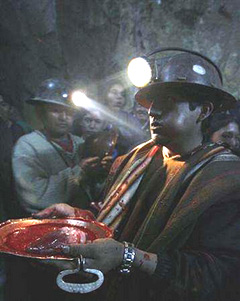 |
 |
 |
 Travel & Outdoors | February 2006 Travel & Outdoors | February 2006  
Llama Sacrifice Kicks Off Bolivia's Carnival
 Helen Popper - Reuters Helen Popper - Reuters


| | Bolivian miners offer a heart of a llama during a traditional sacrifice ceremony at Hitos mine on the outskirts of Oruro, some 124 miles south of La Paz, February 24, 2006. Miners across Bolivia offer thanks to 'Tio', the mythical owner of the mines, on the Friday before Carnival, sacrificing llamas and offering candies, coca leaves and alcohol. (Reuters/David Mercado) |
Every day, miners in the Bolivian city of Oruro emerge from the underground gloom with dusty, grimy faces. On Friday, they emerged dressed in ceremonial ponchos, their faces smeared with the blood of sacrificed llamas.

Simply to say thanks for staying alive for another year, the Oruro miners who eke out a living from abandoned state mines cut the hearts from llamas in a ritual offering to Mother Earth and Tio, who among Aymara Indians is the mythical owner of the mines.

Their work is dangerous, so the offerings must be great.

"I'm 56 and I'm still alive, which surprises me because so many of my friends have died," said Isaac Meneses as the miners gathered at the mouth of the Itos mine near this mining town some 145 miles south of La Paz,

Huddled around a rusty railway cart laden with sweets, confetti and eggs, the miners chewed coca leaves and sprinkled alcohol on the offerings to be taken below in a ritual that takes place every year on the Friday before Carnival celebrations in Bolivia.

As the ritual reached its climax in a vast cavern at the top of the mine shaft, the llamas were brought in. Amid shouts of "Viva" in Aymara, their throats were slit and hearts cut out to be offered on silver plates.

"It's important to give thanks to Tio, because our job is very dangerous, and to Mother Earth, because we are taking riches from her," said Agustin Choque, president of the cooperative formed by unemployed miners that started working Itos about five years ago.

State miner COMIBOL closed down the mine because its deposits of tin, lead and silver were unprofitable.

Rising prices on world markets have revived the cooperative mines and the vast majority of Bolivian miners now work in such cooperatives, despite the risks of working with antiquated equipment.

Until recently, superstition prevented women working as miners, but now wives work alongside their husbands at Itos and other mines in South America's poorest country.

"We do the same work as the men," said young mother Elena Poma, wearing the typical Indian dress of bowler hat, wide skirt and shawl. "The work is very hard and there are many risks, but there are not many other options here."

The miners offerings must be blessed by an Aymara Indian witch doctor before they are pushed along the rail tracks into the darkness of the mine.

"We do this every year because we want to be cared for," said Meneses. "This is a sad life because when you go into the mine you never know if you will come out dead or alive." | 
 | |
 |



